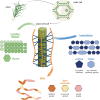Understanding the microbial fibre degrading communities & processes in the equine gut
- PMID: 36635784
- PMCID: PMC9837927
- DOI: 10.1186/s42523-022-00224-6
Understanding the microbial fibre degrading communities & processes in the equine gut
Abstract
The equine gastrointestinal tract is a self-sufficient fermentation system, housing a complex microbial consortium that acts synergistically and independently to break down complex lignocellulolytic material that enters the equine gut. Despite being strict herbivores, equids such as horses and zebras lack the diversity of enzymes needed to completely break down plant tissue, instead relying on their resident microbes to carry out fibrolysis to yield vital energy sources such as short chain fatty acids. The bulk of equine digestion occurs in the large intestine, where digesta is fermented for 36-48 h through the synergistic activities of bacteria, fungi, and methanogenic archaea. Anaerobic gut dwelling bacteria and fungi break down complex plant polysaccharides through combined mechanical and enzymatic strategies, and notably possess some of the greatest diversity and repertoire of carbohydrate active enzymes among characterized microbes. In addition to the production of enzymes, some equid-isolated anaerobic fungi and bacteria have been shown to possess cellulosomes, powerful multi-enzyme complexes that further enhance break down. The activities of both anaerobic fungi and bacteria are further facilitated by facultatively aerobic yeasts and methanogenic archaea, who maintain an optimal environment for fibrolytic organisms, ultimately leading to increased fibrolytic microbial counts and heightened enzymatic activity. The unique interactions within the equine gut as well as the novel species and powerful mechanisms employed by these microbes makes the equine gut a valuable ecosystem to study fibrolytic functions within complex communities. This review outlines the primary taxa involved in fibre break down within the equine gut and further illuminates the enzymatic strategies and metabolic pathways used by these microbes. We discuss current methods used in analysing fibrolytic functions in complex microbial communities and propose a shift towards the development of functional assays to deepen our understanding of this unique ecosystem.
Keywords: Anaerobic fungi; CAZyme; Equine; Fibre; Gastrointestinal tract; Health; Microbiome.
© 2023. The Author(s).
Conflict of interest statement
BC, MB and GW declare their involvement in the brand equiGI, a commercial microbiome testing service provided by Quantal Bioscience. TR and MR declare no competing financial or non-financial interests.
Figures


References
-
- Trinci APJ, Davies DR, Gull K, Lawrence MI, Bonde Nielsen B, Rickers A, et al. Anaerobic fungi in herbivorous animals. Mycol Res. 1994;98(2):129–152. doi: 10.1016/S0953-7562(09)80178-0. - DOI
-
- Vermorel M, Martin-Rosset W. Concepts, scientific bases, structure and validation of the French horse net energy system (UFC) Livest Prod Sci. 1997;47(3):261–275. doi: 10.1016/S0301-6226(96)01410-8. - DOI
-
- Al Jassim RAM, Scott PT, Krause D, Denman S, McSweeney CS. Cellulolytic and lactic acid bacteria in the gastrointestinal tract of the horse. Recent Adv Anim Nutr Aust. 2005;15:155–163.
Publication types
LinkOut - more resources
Full Text Sources
